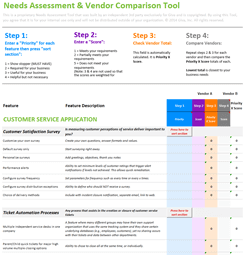Negative Words vs. Positive Words in Customer Service
The power of words is undeniable. Every customer service interaction, whether online, over the phone, or in person, has the potential to influence customer satisfaction. Understanding how language shapes the customer experience is key to positive interactions and resolving issues effectively.

In this article, we review what not to do and what to do in difficult customer service interactions, and we give many examples of negative-word responses with alternatives using words that are more positive.
The Difficult Temptation: Negative Words in the "Heat of Battle"
In challenging customer service situations, the temptation to use negative words can be strong. During difficult interactions, emotions may run high. It can therefore be easier to use negative phrases in response to frustration, impatience, or stress. Negative language might come across as dismissive, defensive, or unhelpful, increasing the customer's concerns. It can also escalate tensions, damage relationships, and harm your company's reputation. Here's a brief insight into handling such situations:
What Not to Do
- Avoid blaming the customer or other departments for the issue.
- Don't dismiss or disparage customer concerns.
- Be careful of defensive responses.
What to Do Instead
- Use a calm and empathetic tone to diffuse tension and show understanding.
- Frame responses in a positive light, focusing on what can be done rather than what cannot.
- Apologize for any inconvenience, take ownership of the issue, and express a commitment to finding a solution.
- Provide actionable solutions or alternatives to address the customer's concerns.
- Demonstrate active listening by summarizing the issue and ensuring the customer feels heard.
- Maintain professionalism in language and demeanor.
35 Examples of Negative Words vs. Positive Words in Customer Service
The following goes through a list of negative phrases that can sometimes be used in a customer service interaction. It also notes why the phrase is negative in a characteristic designation. Each negative phrase is followed by a much more customer-friendly, positive alternative.
Negative Characteristic |
Negative Response |
Positive Response |
Blaming or Deflecting Responsibility |
I can't help if you don't have the right documentation. |
Let's work together to gather the needed documentation and find a solution. |
It's not my fault; it's the system's fault. |
I apologize for the inconvenience caused by the system. Let's see how we can work around it to meet your needs. |
|
It's not our fault. |
I'm sorry for the inconvenience. Let's figure out how we can make this right for you. |
|
That's not my department. |
I may not be an expert in this area, but I'll connect you with someone who can provide the assistance you need. |
|
That's not our problem. |
I understand this is a concern for you. Let me see how we can address and resolve the issue. |
|
You should have read the instructions. |
I apologize if there was any confusion. Let's review the instructions together, and I'll guide you through the process. |
|
You should have read the terms and conditions. |
I apologize for any confusion. Let's work together to find a resolution. |
|
You're the first one to complain about this. |
I appreciate your feedback; let's work together to make sure this issue gets resolved. |
|
Dismissing Customer Concerns |
You're overreacting. |
I understand this may be frustrating. Let's discuss your concerns, and I'll do my best to address them appropriately. |
You're the only one with this problem. |
I'm sorry to hear you're experiencing this. Let's work together to figure out a solution. |
|
Failure to Offer Solutions |
I can't do anything about it. |
I'll investigate the issue further and find a way to help you. |
I can't help you with that. |
While I may not have the answer now, I'll find someone who can assist you better. |
|
There's nothing I can do to help. |
I may not have an immediate solution, but I'm committed to finding a way to assist you. |
|
There's nothing more I can do. |
I'll explore additional options to see if there's anything else we can try. |
|
You'll have to live with the product/service as is. |
I understand your concerns. Let's explore how we can enhance your current experience or find alternatives that better suit your needs. |
|
Inflexibility |
I can't do anything until you provide more information. |
I understand more information is needed. Let's work together to gather the necessary details to resolve your issue. |
I can't offer you any compensation. |
I understand your frustration. Let me see what options are available for compensation or resolution that would be fair and satisfactory for you. |
|
I can't make any exceptions. |
While exceptions are rare, I'll review your case to see if there's anything we can do to assist you. |
|
That's not our policy. |
While our policy is X, I'll see what exceptions or alternatives we can explore for your situation. |
|
Lack of Responsibility |
I can't do anything about that. |
Let me see what I can do to assist you in finding a solution. |
I can't make any promises. |
While I can't guarantee specific outcomes, I'll do my best to address your concerns and find a satisfactory resolution. |
|
I'm not responsible for that. |
Even though it's not directly within my scope, I'll assist you in finding the right person to handle your concern. |
|
It's company policy; there's nothing I can do. |
I understand this may be frustrating. Let's explore possible alternatives within our policies. |
|
It's not my department. |
While it may not be my primary area, I'll guide you to the right department or individual who can provide the assistance you need. |
|
It's not my fault. |
I apologize for the inconvenience. Let's focus on finding a solution and making things right for you. |
|
It's not my responsibility. |
I may not be the expert in this area, but I'll connect you with someone who can provide the assistance you need. |
|
Poor Empathy and Understanding |
I don't know. |
I may not have the information right now, but I'll find out for you. Please allow me a moment. |
You're being unreasonable. |
I understand your concerns may be challenging. Let's work together to find a solution that meets both your needs and our capabilities. |
|
Refusal to Provide Information |
I can't give you that information. |
I'll check the details and provide the information you need. |
I don't have the information. |
I'll gather the necessary information for you. Please bear with me for a moment. |
|
Rude or Offensive Language |
You're wrong. |
I appreciate your perspective. Let's review the information together to ensure we're on the same page. |
Time Insensitivity |
I can't do it any faster. |
I'll do my best to expedite the process. |
I'm not authorized to make that decision. |
I'll escalate this to the appropriate authority for review. In the meantime, I'll do my best to assist you within my capacity. |
|
You'll have to wait. |
I apologize for the wait. I'll do my best to expedite the resolution for you. |
|
You're just going to have to wait your turn. |
I apologize for the wait. I'll do my best to address your concerns as soon as possible. |
Conclusion: How to Prepare Agents to Keep Customer Interactions Positive
The following are some strategies customer service departments or managers can implement to prepare agents to avoid negative words and use positive ones instead:
- Develop comprehensive training programs that emphasize the importance of positive communication.
- Create a set of positive language guidelines that agents can refer to during interactions.
- Regularly give constructive feedback on recorded or monitored interactions.
- Conduct empathy training sessions to help agents understand and connect with customers on an emotional level.
- Encourage continuous learning through workshops, webinars, or online courses focused on communication skills.
- Facilitate team discussions where agents can share successful strategies for using positive language.
- Analyze customer feedback to identify patterns related to language preferences.
- Provide sensitivity training to ensure that positive language is respectful and appropriate across diverse customer demographics.
By incorporating these strategies, customer service departments can create a positive and supportive environment that helps agents respond helpfully, thus enhancing the overall customer experience.





